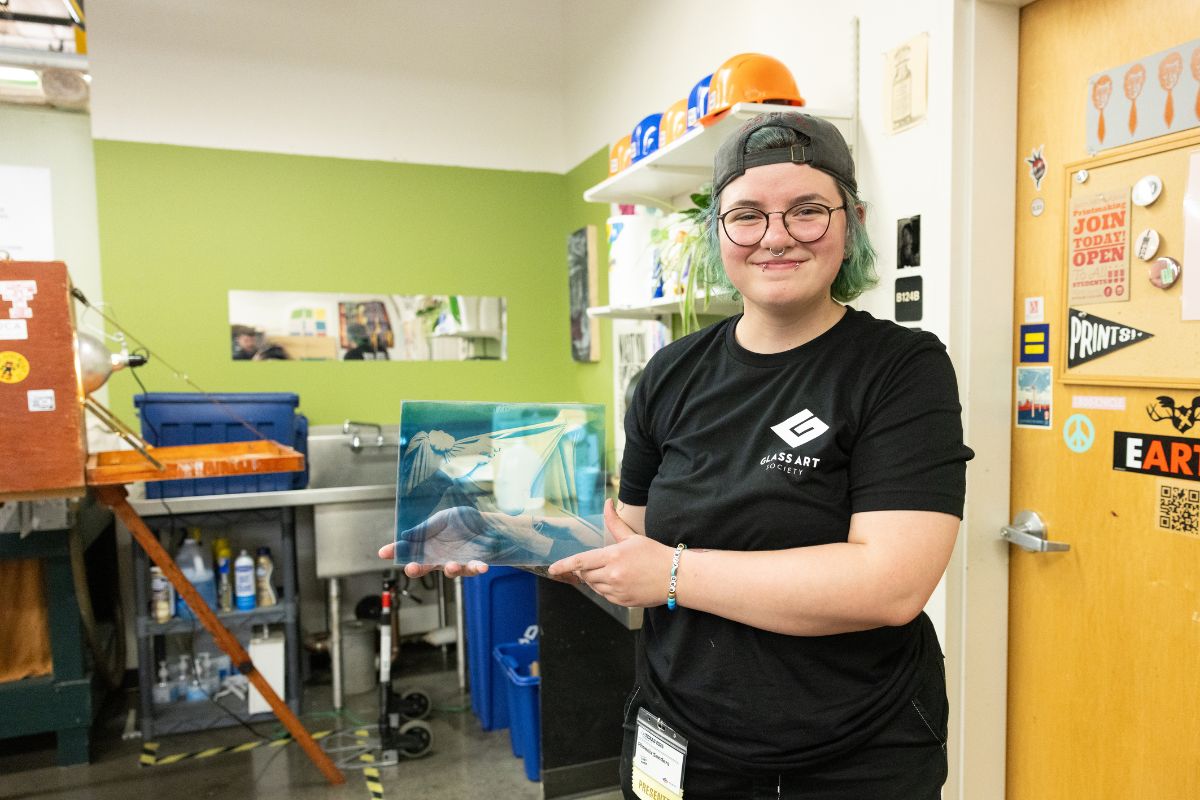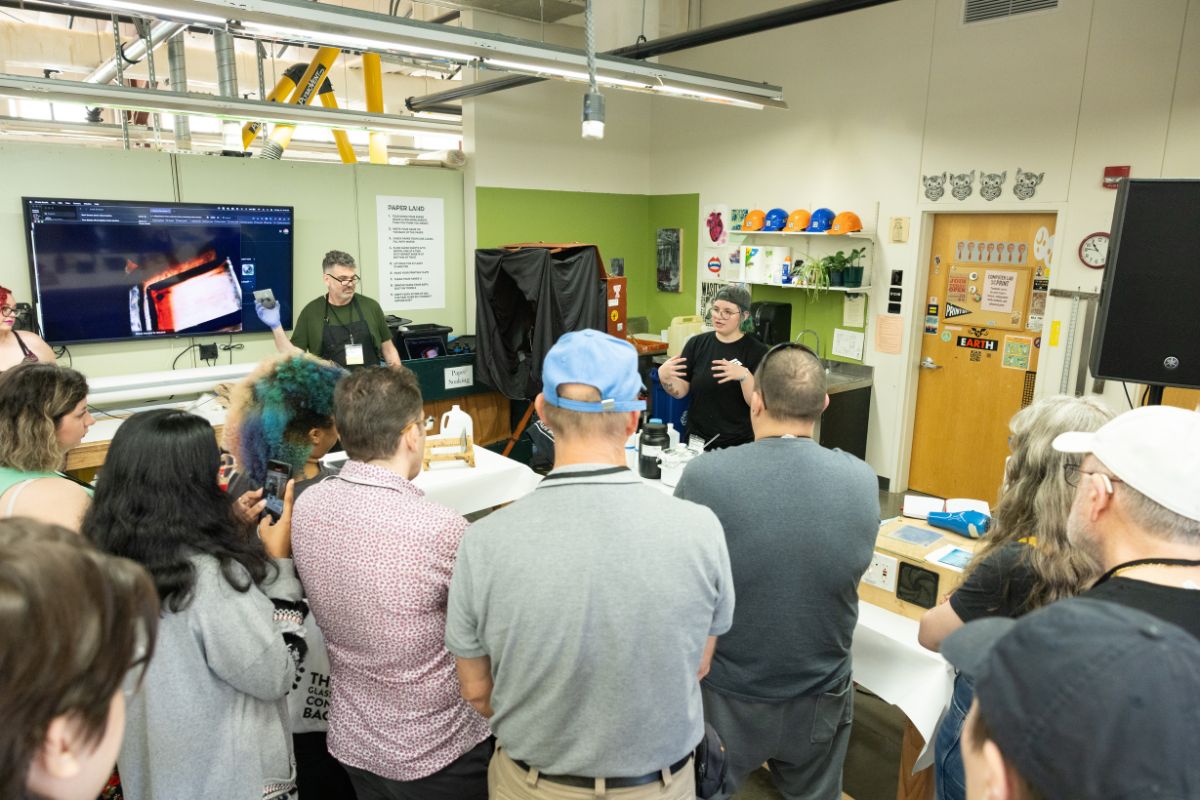Blown Away: Glass Art World Converges at UTA

The University of Texas at Arlington recently hosted the 2025 Glass Art Society Conference, attracting hundreds of glass artists, curators, educators and scholars from around the globe. It marked the first time the international event has taken place in Texas since its inception in 1971.
Titled “Trailblazing New Traditions,” the four-day conference featured a comprehensive program of live glassblowing demonstrations, exhibitions, artist talks and panel discussions. It showcased the vibrant glass art community in the region, from UT Arlington and its state-of-the-art glass facilities to SiNaCa Studios in Fort Worth, a nonprofit led by UTA alumni that offers hands-on experiences with glassblowing through education and community engagement.
“To see everything come together and have so many artists from across the world come to UTA felt really nice,” said Justin Ginsberg, associate professor and glass art coordinator in the Department of Art and Art History. “The conference was not only about highlighting UTA and our glass area but about giving our students the opportunity to meet a large network of people and build connections. It was also very rewarding to see our alumni come back and learn about all the great stuff they’ve gone on to do. This was very special.”
Two recent UTA graduates, Phoenix Sanders and Isabella Posca, were selected by the conference planning committee to serve as presenters.

Sanders presented a lecture and demonstration titled “We See Through a Glass Darkly: Reviving 19th-Century Photographic Processes on Glass” alongside Distinguished Senior Lecturer Scott Hilton. The duo explored the history of glass in photography and demonstrated two 19th-century techniques for creating photographic images on glass. Posca participated in a panel of artists and researchers that delved into the latest findings on the impact of glass art on mental well-being.
“One day Justin Ginsberg stopped me and said, ‘Hey, you can put photos on glass, right?’ and I said yes—even though I’d never done it,” Sanders said. “It was something I knew existed, and I figured I could learn it. I had so many ideas on how to make it work and spent about 10 months researching, with lots of trial and error.”
Sanders, a glass artist specializing in goblet-making, will soon begin a six-week internship at WheatonArts, an internationally acclaimed arts community in Millville, New Jersey. During her undergraduate career, Posca was named a McNair Scholar and conducted research on what makes glassblowing distinct from other art therapy mediums.
“The conference was amazing because everyone came together to share knowledge and ideas,” Posca said. “I actually connected with more people who want to be part of my research—some are interested in assisting me, others in participating as interviewees. As an artist, I learned a lot. I’m still a glass artist at the end of the day, and I picked up a lot of new techniques and met people I could see myself collaborating with in the future.”
Ginsberg said UTA’s glass faculty and curriculum create a wide range of opportunities for students to pursue their passions. A robust, well-rounded education, he noted, often leads to greater opportunities after graduation.
In 2024, Loews Hotel and Co commissioned UTA’s glass program to commemorate the opening of the Loews Arlington Hotel and Convention Center with a glass-blown sculpture, now permanently displayed in the hotel’s library. The collaboration also included the design and fabrication of a custom glassware set for a signature cocktail served to guests.

UTA’s glass program offers students the opportunity to earn a Bachelor of Fine Arts in art with a concentration in glass, as well as a Master of Fine Arts in art with a glass track. The cutting-edge facilities provide a world-class studio environment for exploring a wide range of techniques, including glassblowing, flameworking, fusing, casting and fabrication.
“The first piece of glassblowing equipment was brought to UTA back in 1975, and here we are 50 years later hosting an international conference,” Ginsberg said. “It was quite a feat. Not only did we help showcase the DFW area, but more importantly, we showcased UTA’s education.”
About The University of Texas at Arlington (UTA)
Celebrating its 130th anniversary in 2025, The University of Texas at Arlington is a growing public research university in the heart of the thriving Dallas-Fort Worth metroplex. With a student body of over 41,000, UTA is the second-largest institution in the University of Texas System, offering more than 180 undergraduate and graduate degree programs. Recognized as a Carnegie R-1 university, UTA stands among the nation’s top 5% of institutions for research activity. UTA and its 280,000 alumni generate an annual economic impact of $28.8 billion for the state. The University has received the Innovation and Economic Prosperity designation from the Association of Public and Land Grant Universities and has earned recognition for its focus on student access and success, considered key drivers to economic growth and social progress for North Texas and beyond.